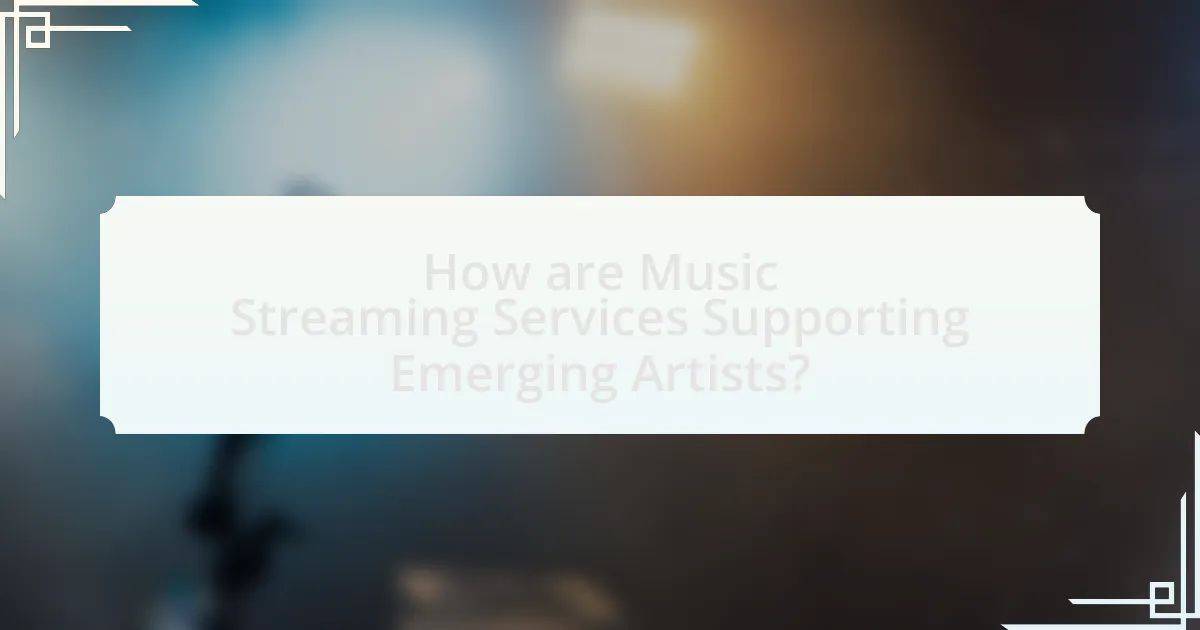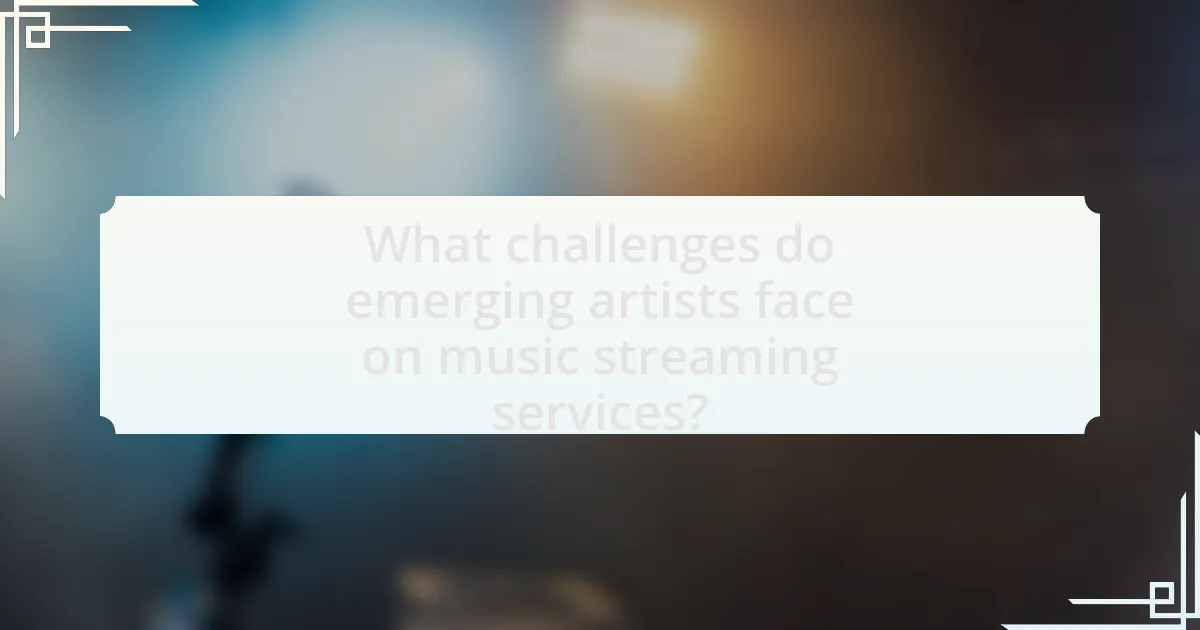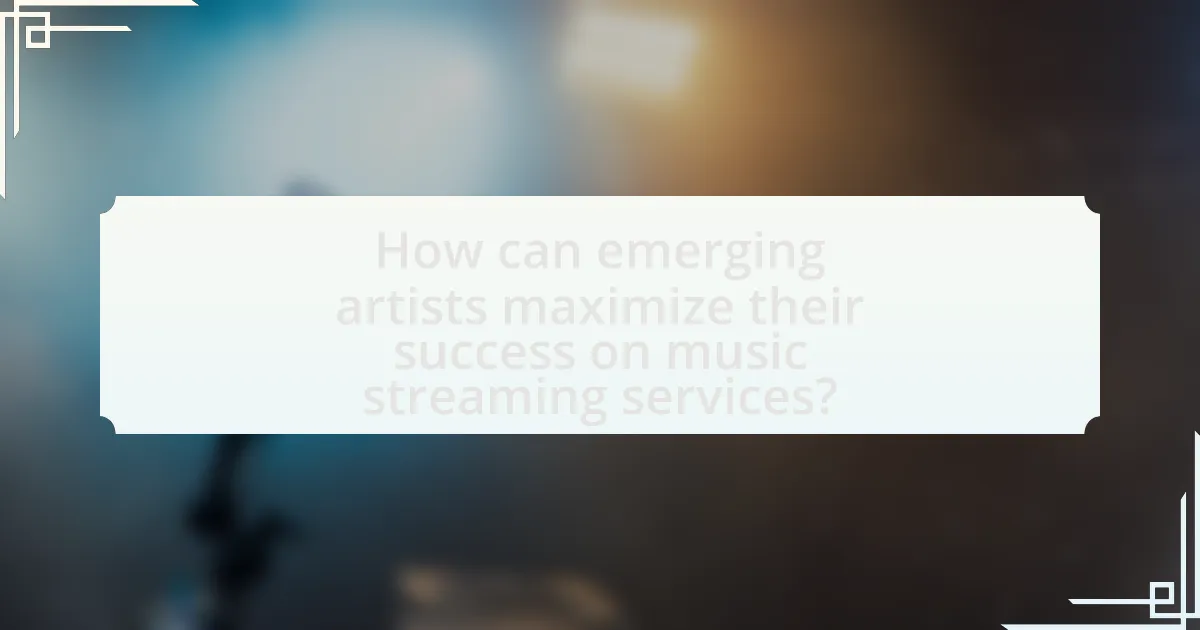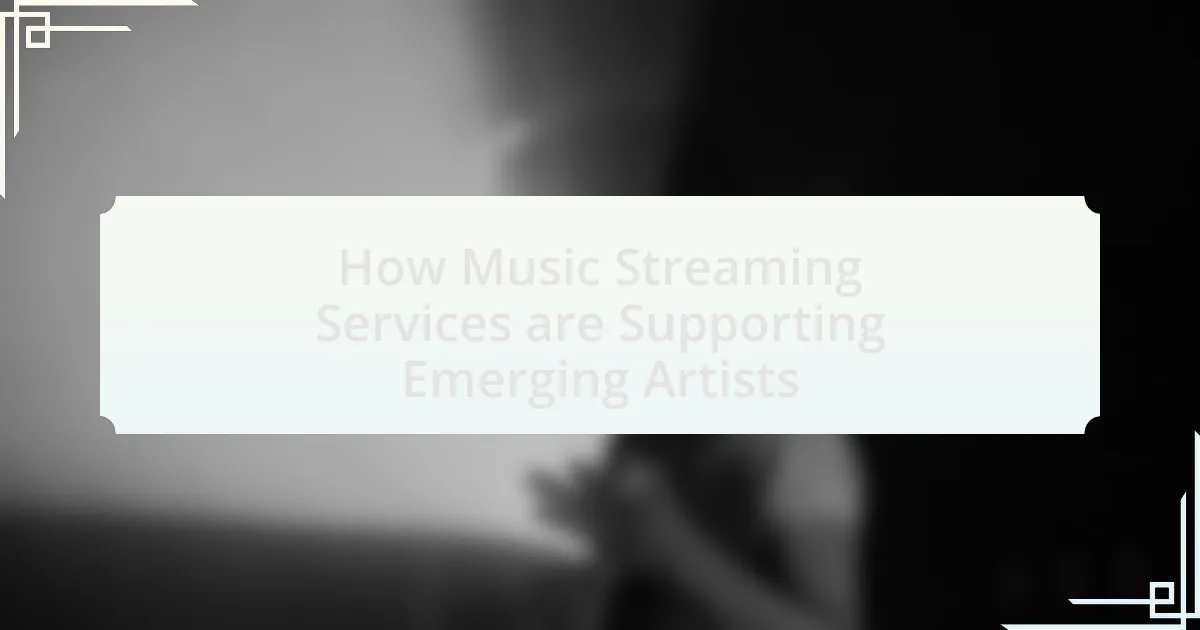Music streaming services, such as Spotify and Apple Music, play a pivotal role in supporting emerging artists by providing platforms for music distribution, exposure, and monetization. These services enable new musicians to reach global audiences without traditional record label constraints, significantly impacting their careers. Key features include curated playlists, data analytics tools, and promotional resources that enhance visibility and audience engagement. Despite challenges like low revenue payouts and intense competition, streaming platforms democratize access to the music industry, allowing emerging artists to build their careers effectively. The article explores the advantages, challenges, and strategies for new musicians navigating this evolving landscape.

How are Music Streaming Services Supporting Emerging Artists?
Music streaming services support emerging artists by providing platforms for distribution, exposure, and monetization. These services, such as Spotify and Apple Music, allow new musicians to upload their music easily, reaching global audiences without the need for traditional record labels. For instance, Spotify’s “Fresh Finds” playlist specifically curates tracks from up-and-coming artists, enhancing their visibility. Additionally, data analytics tools offered by these platforms enable artists to understand their audience better and tailor their marketing strategies effectively. According to a report by the International Federation of the Phonographic Industry (IFPI), 70% of artists believe streaming services have positively impacted their careers by facilitating access to listeners and generating revenue through streams.
What role do music streaming services play in the music industry?
Music streaming services play a crucial role in the music industry by providing a platform for artists to distribute their music widely and access a global audience. These services, such as Spotify and Apple Music, enable emerging artists to reach listeners without the need for traditional record label support, which can be financially and logistically restrictive. According to a report by the International Federation of the Phonographic Industry (IFPI), streaming accounted for 62.1% of global recorded music revenues in 2020, highlighting its significance in the industry. Additionally, streaming platforms often offer data analytics tools that help artists understand their audience demographics and listening habits, allowing them to tailor their marketing strategies effectively. This democratization of music distribution empowers new talent and fosters diversity in the music landscape.
How have music streaming services changed the way music is consumed?
Music streaming services have fundamentally transformed music consumption by providing instant access to vast libraries of songs and personalized listening experiences. This shift has led to a decline in physical album sales and downloads, with streaming accounting for over 80% of music industry revenue in 2020, according to the Recording Industry Association of America (RIAA). Additionally, algorithms and curated playlists enhance user engagement by recommending music based on individual preferences, thereby increasing exposure for emerging artists. This accessibility allows listeners to discover new music easily, fostering a more diverse musical landscape.
What impact do streaming platforms have on traditional music distribution?
Streaming platforms significantly disrupt traditional music distribution by shifting the focus from physical sales to digital access. This transition has led to a decline in album sales, with the Recording Industry Association of America reporting that physical album sales dropped by 23% from 2019 to 2020, while streaming revenue increased by 13% during the same period. Consequently, artists now prioritize digital releases and streaming strategies over traditional album formats, altering how music is marketed and consumed. This shift also democratizes access for emerging artists, allowing them to reach global audiences without the need for traditional distribution channels.
Why are emerging artists turning to music streaming services?
Emerging artists are turning to music streaming services primarily for increased visibility and access to a global audience. These platforms, such as Spotify and Apple Music, provide artists with the ability to distribute their music widely without the need for traditional record label support. According to a report by the International Federation of the Phonographic Industry (IFPI), over 400 million people globally use music streaming services, which significantly enhances the potential for new artists to reach listeners. Additionally, streaming services often offer data analytics tools that help artists understand their audience demographics and listening habits, allowing for more targeted marketing strategies. This combination of broad reach and valuable insights makes music streaming services an attractive option for emerging artists seeking to establish their careers.
What advantages do streaming services offer to new musicians?
Streaming services provide new musicians with significant advantages, including increased exposure, accessibility to a global audience, and data analytics for audience engagement. These platforms allow emerging artists to share their music widely without the need for traditional record label support, enabling them to reach millions of listeners instantly. For instance, Spotify reported that over 60,000 new tracks are uploaded daily, showcasing the platform’s vast reach and the potential for new artists to gain visibility. Additionally, streaming services offer detailed analytics that help musicians understand listener demographics and preferences, allowing them to tailor their marketing strategies effectively. This combination of exposure, accessibility, and data-driven insights empowers new musicians to build their careers in a competitive industry.
How do streaming platforms help in reaching a wider audience?
Streaming platforms help in reaching a wider audience by providing global access to music, allowing artists to distribute their work without geographical limitations. These platforms, such as Spotify and Apple Music, utilize algorithms and playlists that promote songs to users based on their listening habits, significantly increasing exposure. For instance, Spotify’s editorial playlists can reach millions of listeners, enabling emerging artists to gain traction quickly. Additionally, streaming services often feature social sharing options, allowing fans to share music easily, further expanding an artist’s reach.
What features of music streaming services benefit emerging artists?
Music streaming services benefit emerging artists through features such as algorithm-driven playlists, direct fan engagement tools, and data analytics. Algorithm-driven playlists, like Spotify’s Discover Weekly, expose new music to a wider audience, increasing the chances of discovery for emerging artists. Direct fan engagement tools, such as social media integration and messaging features, allow artists to connect with their audience, fostering a loyal fan base. Data analytics provide insights into listener demographics and behavior, enabling artists to tailor their marketing strategies effectively. These features collectively enhance visibility, engagement, and strategic planning for emerging artists in the competitive music landscape.
How do playlists and algorithmic recommendations support new talent?
Playlists and algorithmic recommendations significantly support new talent by increasing their visibility and accessibility to a broader audience. Streaming platforms like Spotify and Apple Music curate playlists that feature emerging artists, allowing listeners to discover new music easily. For instance, Spotify’s “Fresh Finds” playlist is specifically designed to highlight up-and-coming artists, resulting in millions of streams and increased fan engagement for those featured. Additionally, algorithmic recommendations analyze user listening habits to suggest new artists that align with their preferences, further promoting exposure. According to a 2021 report by the Music Industry Research Association, playlists and algorithms account for over 30% of music discovery, demonstrating their crucial role in supporting new talent in the music industry.
What promotional tools are available for emerging artists on these platforms?
Emerging artists have access to several promotional tools on music streaming platforms, including playlist placements, social media integration, and targeted advertising. Playlist placements allow artists to reach wider audiences by featuring their music in popular curated playlists, which can significantly increase streams and visibility. Social media integration enables artists to share their music directly on platforms like Instagram and TikTok, leveraging user-generated content to enhance engagement. Targeted advertising options allow artists to promote their music to specific demographics, increasing the likelihood of reaching potential fans. These tools collectively support emerging artists in building their audience and gaining traction in the competitive music industry.

What challenges do emerging artists face on music streaming services?
Emerging artists face significant challenges on music streaming services, primarily due to low revenue payouts and intense competition. The average payout per stream on platforms like Spotify is approximately $0.003 to $0.005, making it difficult for new artists to earn a sustainable income from their music. Additionally, the sheer volume of content uploaded daily—over 60,000 tracks—creates a saturated market where emerging artists struggle to gain visibility and attract listeners. This competition often leads to reliance on social media and marketing strategies, which can be resource-intensive and challenging for artists without established fan bases.
How do competition and visibility affect new artists?
Competition and visibility significantly impact new artists by influencing their ability to gain recognition and establish a fan base. High competition in the music industry can make it challenging for emerging artists to stand out, as they must differentiate themselves from numerous other creators. According to a report by the International Federation of the Phonographic Industry (IFPI), over 60,000 new tracks are uploaded to streaming platforms daily, highlighting the intense competition new artists face.
Visibility, on the other hand, is crucial for attracting listeners and building a following. Music streaming services often provide curated playlists and promotional tools that enhance visibility for new artists. For instance, Spotify’s “Fresh Finds” playlist showcases emerging talent, allowing artists to reach wider audiences. Research indicates that artists featured on such playlists can experience a significant increase in streams and followers, demonstrating the direct correlation between visibility and success in the music industry.
What strategies can emerging artists use to stand out in a crowded market?
Emerging artists can stand out in a crowded market by leveraging social media platforms to build a personal brand and engage directly with their audience. This strategy is effective because social media allows artists to showcase their unique style, share behind-the-scenes content, and interact with fans, fostering a loyal community. According to a 2021 report by the International Federation of the Phonographic Industry, 70% of music consumers discover new artists through social media, highlighting its importance in artist visibility. Additionally, collaborating with other artists and influencers can expand reach and introduce emerging artists to new audiences, further enhancing their market presence.
How do streaming royalties impact the financial success of new musicians?
Streaming royalties significantly impact the financial success of new musicians by providing a primary revenue stream that can lead to increased exposure and audience growth. As new artists distribute their music through platforms like Spotify and Apple Music, they earn royalties based on the number of streams, which can accumulate to substantial amounts over time. For instance, in 2021, Spotify paid an average of $0.003 to $0.005 per stream, meaning that an artist would need millions of streams to generate a sustainable income. This model allows emerging musicians to reach global audiences without the need for traditional record label support, thus democratizing access to the music industry. Additionally, successful streaming can lead to opportunities for live performances, merchandise sales, and collaborations, further enhancing their financial viability.
What are the common misconceptions about music streaming services?
Common misconceptions about music streaming services include the belief that they do not fairly compensate artists and that they limit music discovery. Many people think streaming services pay artists very little, but in reality, platforms like Spotify and Apple Music have implemented various payment models that can provide significant revenue, especially for popular tracks. According to a 2021 report by the International Federation of the Phonographic Industry, streaming accounted for 62% of global recorded music revenue, indicating that it is a vital source of income for artists. Additionally, some users believe that streaming services hinder music discovery; however, algorithms and curated playlists on these platforms often help listeners discover new and emerging artists, enhancing their exposure.
How do streaming services actually support artist development?
Streaming services support artist development by providing platforms for exposure, audience engagement, and data analytics. These services enable emerging artists to distribute their music globally without the need for traditional record labels, allowing them to reach wider audiences. For instance, platforms like Spotify and Apple Music offer curated playlists that can significantly increase an artist’s visibility, leading to more streams and potential fan growth. Additionally, streaming services provide artists with valuable data on listener demographics and engagement, which helps them tailor their marketing strategies and understand their audience better. According to a report by the International Federation of the Phonographic Industry (IFPI), over 70% of music listeners discover new artists through streaming platforms, highlighting their role in artist development.
What is the reality of earnings from music streaming for emerging artists?
The reality of earnings from music streaming for emerging artists is that they typically receive very low payouts per stream, often averaging between $0.003 and $0.005 per stream. This means that to earn a substantial income, emerging artists need millions of streams, which can be challenging to achieve without significant marketing and audience engagement. For instance, a study by the Music Industry Research Association found that an artist would need approximately 250,000 streams to earn around $1,000, highlighting the difficulty for new artists to generate sustainable income through streaming alone.

How can emerging artists maximize their success on music streaming services?
Emerging artists can maximize their success on music streaming services by actively engaging with their audience and utilizing promotional tools offered by these platforms. Engaging with listeners through social media and live performances can build a loyal fan base, while leveraging features like playlists, collaborations, and targeted advertising can enhance visibility. For instance, Spotify’s editorial playlists have been shown to significantly increase streams, with tracks featured on popular playlists experiencing up to a 300% increase in plays. Additionally, utilizing data analytics provided by streaming services allows artists to understand their audience better and tailor their marketing strategies effectively.
What best practices should emerging artists follow on streaming platforms?
Emerging artists should prioritize consistent content release on streaming platforms to build and maintain audience engagement. Regularly releasing new music, such as singles or EPs, keeps listeners interested and encourages them to return for more. Additionally, artists should utilize social media to promote their streaming profiles and engage with fans, as platforms like Instagram and TikTok can drive traffic to their music. Collaborating with other artists can also expand their reach, as cross-promotion exposes them to new audiences. Furthermore, artists should analyze streaming data to understand listener demographics and preferences, allowing them to tailor their marketing strategies effectively. According to a report by the International Federation of the Phonographic Industry, artists who actively engage with their audience on social media see a 30% increase in streaming numbers.
How can artists effectively use social media to promote their music?
Artists can effectively use social media to promote their music by engaging with their audience through consistent content sharing, targeted advertising, and interactive features. Consistent posting of music-related content, such as behind-the-scenes footage, live performances, and personal stories, helps build a loyal fan base. Targeted advertising on platforms like Facebook and Instagram allows artists to reach specific demographics, increasing visibility among potential listeners. Additionally, utilizing interactive features like polls, Q&A sessions, and live streams fosters a sense of community and encourages fan interaction, which can lead to increased shares and organic reach. According to a 2021 report by the International Federation of the Phonographic Industry, 70% of music fans discover new artists through social media, highlighting its effectiveness as a promotional tool.
What role does audience engagement play in an artist’s success?
Audience engagement is crucial for an artist’s success as it directly influences their visibility, fan loyalty, and revenue generation. Engaged audiences are more likely to share an artist’s work, attend live performances, and purchase merchandise, which enhances the artist’s marketability. For instance, a study by Nielsen Music found that artists with higher engagement levels on social media platforms see a 30% increase in concert attendance and a significant boost in streaming numbers. This correlation underscores the importance of building a strong connection with fans, as it not only fosters a dedicated following but also drives financial success through various revenue streams.
What resources are available for emerging artists on music streaming services?
Emerging artists have access to various resources on music streaming services, including promotional tools, analytics, and distribution support. For instance, platforms like Spotify offer tools such as Spotify for Artists, which provides insights into listener demographics and engagement metrics, enabling artists to tailor their marketing strategies effectively. Additionally, services like SoundCloud and Bandcamp allow artists to upload their music directly, facilitating easier access to audiences without the need for traditional record labels. Furthermore, many streaming services curate playlists that feature emerging talent, enhancing visibility and potential listener reach. These resources collectively empower emerging artists to grow their careers in a competitive music landscape.
How can artists access educational materials and support networks?
Artists can access educational materials and support networks through various online platforms and community organizations. Music streaming services like Spotify and SoundCloud offer resources such as tutorials, webinars, and articles aimed at helping emerging artists develop their skills and navigate the industry. Additionally, organizations like the American Society of Composers, Authors, and Publishers (ASCAP) provide networking opportunities, workshops, and mentorship programs that connect artists with industry professionals. These resources are designed to enhance artists’ knowledge and foster collaboration within the music community.
What tools can help artists analyze their performance on streaming platforms?
Artists can utilize tools such as Spotify for Artists, Apple Music for Artists, and SoundCloud Insights to analyze their performance on streaming platforms. These tools provide detailed analytics on listener demographics, streaming numbers, and engagement metrics. For instance, Spotify for Artists offers real-time data on how many times a track has been streamed, the geographic location of listeners, and playlist placements, enabling artists to make informed decisions about marketing and touring. Similarly, Apple Music for Artists provides insights into song performance and audience engagement, while SoundCloud Insights tracks plays, likes, and comments, helping artists understand their audience better.
What are the future trends for music streaming services and emerging artists?
Future trends for music streaming services and emerging artists include increased use of artificial intelligence for personalized recommendations, enhanced monetization options for artists, and a focus on community engagement through social features. Streaming platforms are leveraging AI to analyze listener behavior, which allows for tailored playlists and discovery of new artists, thereby increasing exposure for emerging talent. Additionally, services are introducing features like direct fan-to-artist payments and subscription models that provide artists with a larger share of revenue, addressing long-standing concerns about fair compensation. According to a 2023 report by MIDiA Research, 70% of emerging artists reported that streaming services have become their primary source of income, highlighting the growing importance of these platforms in supporting new music creators.
How might technology shape the future of music distribution?
Technology will significantly shape the future of music distribution by enhancing accessibility and personalization for listeners while providing emerging artists with innovative platforms to reach audiences. Streaming services like Spotify and Apple Music utilize algorithms to curate personalized playlists, which increases listener engagement and helps new artists gain visibility. According to a report by the International Federation of the Phonographic Industry (IFPI), streaming accounted for 62.1% of global recorded music revenues in 2020, demonstrating the shift towards digital distribution. Additionally, advancements in blockchain technology may enable artists to receive fairer compensation through direct transactions with fans, further transforming the distribution landscape.
What emerging platforms should artists be aware of?
Artists should be aware of platforms like Audius, SoundCloud, and Bandcamp. Audius is a decentralized music streaming service that allows artists to upload their music directly and earn revenue without intermediaries, which is crucial for emerging artists seeking control over their work. SoundCloud offers a vast community and tools for artists to share their music and connect with fans, making it a popular choice for new musicians. Bandcamp enables artists to sell their music and merchandise directly to fans, providing a sustainable income model that supports independent creators. These platforms are gaining traction and provide unique opportunities for artists to reach audiences and monetize their work effectively.
What practical tips can emerging artists implement today?
Emerging artists can implement several practical tips today to enhance their presence and success in the music industry. First, they should utilize music streaming platforms like Spotify and Apple Music to distribute their music widely, as these services have millions of active users, providing significant exposure. Second, artists can engage with their audience through social media channels, which allows for direct interaction and community building, essential for fan loyalty. Third, they should consider collaborating with other artists to tap into each other’s fan bases, thereby increasing their reach. Additionally, artists can analyze streaming data to understand listener demographics and preferences, enabling them to tailor their marketing strategies effectively. These strategies are supported by the fact that over 60% of music listeners discover new artists through streaming services, highlighting the importance of these platforms in an artist’s growth.

Leave a Reply